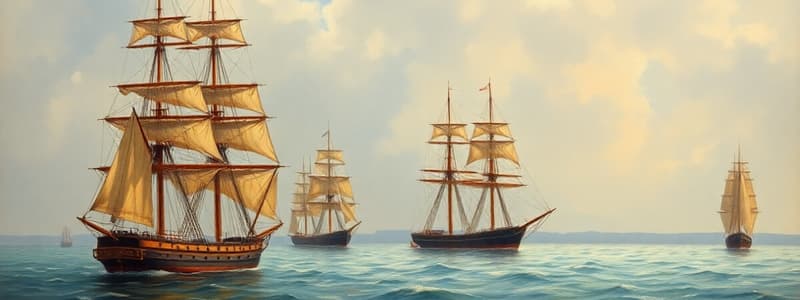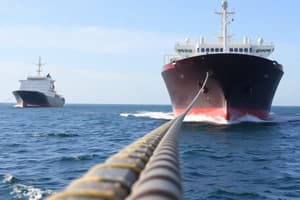Podcast
Questions and Answers
Which characteristic primarily defined ships-of-the-line during the age of sail?
Which characteristic primarily defined ships-of-the-line during the age of sail?
- Their status as the largest warships, carrying a high number of guns. (correct)
- Their superior speed compared to frigates and sloops-of-war.
- Their role as dedicated commerce raiders, disrupting enemy trade routes.
- Their advanced maneuverability in shallow coastal waters.
How did frigates generally compare to ships-of-the-line in terms of size and speed?
How did frigates generally compare to ships-of-the-line in terms of size and speed?
- Frigates were larger but had comparable speed to ships-of-the-line.
- Frigates were smaller and faster than ships-of-the-line. (correct)
- Frigates were approximately the same size and speed as ships-of-the-line.
- Frigates were larger and slower than ships-of-the-line.
What was the typical armament range for sloops-of-war?
What was the typical armament range for sloops-of-war?
- 28 to 44 guns.
- 44 to 64 guns.
- 10 to 20 guns. (correct)
- 64 to over 100 guns.
Which of the following statements best describes the role of each class of warship relative to one another?
Which of the following statements best describes the role of each class of warship relative to one another?
Considering the characteristics of ships-of-the-line, frigates and sloops-of-war, how might a naval strategist utilize these three classes of ships in a coordinated naval operation?
Considering the characteristics of ships-of-the-line, frigates and sloops-of-war, how might a naval strategist utilize these three classes of ships in a coordinated naval operation?
Flashcards
Ships-of-the-line
Ships-of-the-line
Battleships of the sailing era, the largest warships carrying 64-100+ guns.
Frigates
Frigates
18th-century cruisers, smaller and faster than ships-of-the-line, carrying 28-44 guns.
Sloops-of-war
Sloops-of-war
Small sailing warships carrying 10-20 guns.
3 Major Classes of Warships at Navy's Inception
3 Major Classes of Warships at Navy's Inception
Ships-of-the-line, Frigates and Sloops-of-war.
Signup and view all the flashcards
American Revolutionary War
American Revolutionary War
Ships-of-the-line were not a significant part of the US Navy until after this war.
Signup and view all the flashcardsStudy Notes
- Three major classes of warships existed at the inception of the navy.
Ships-of-the-line
- They were the battleships of the sailing days.
- These ships were the largest of all sailing warships.
- They carried 64 to over 100 guns of various sizes.
- The Navy’s ships-of-the-line didn’t exist until years after the Revolutionary War.
Frigates
- They were the cruisers of the 18th century.
- These cruisers were next in size, usually smaller and faster than an average ship-of-the-line.
- They generally carried 28 to 44 guns.
Sloops-of-war
- They were small sailing warships.
- They Carried 10 to 20 guns.
Studying That Suits You
Use AI to generate personalized quizzes and flashcards to suit your learning preferences.




